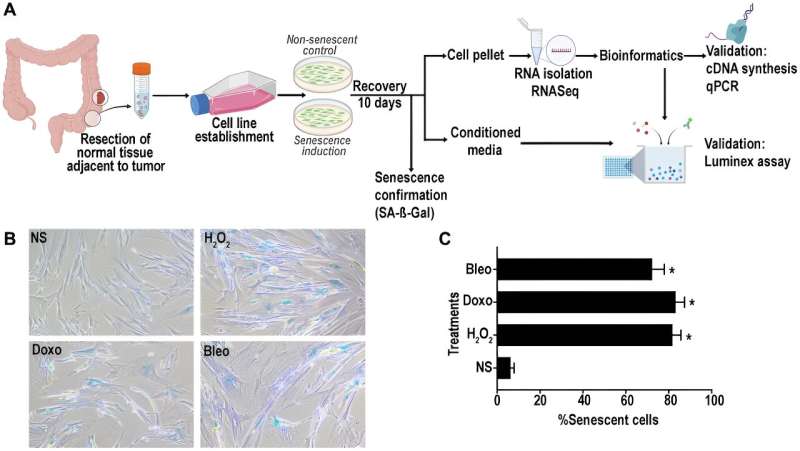This article has been reviewed according to Science X's editorial process and policies. Editors have highlighted the following attributes while ensuring the content's credibility:
fact-checked
proofread
Mapping the core senescence phenotype of human colon fibroblasts

A new research paper titled "Mapping the core senescence phenotype of primary human colon fibroblasts" has been published in Aging.
Advanced age is the largest risk factor for many diseases and several types of cancer, including colorectal cancer (CRC). Senescent cells are known to accumulate with age in various tissues, where they can modulate the surrounding tissue microenvironment through their senescence associated secretory phenotype (SASP).
Recently, researchers have shown that there is an increased number of senescent cells in the colons of CRC patients and demonstrated that senescent fibroblasts and their SASP create microniches in the colon that are conducive to CRC onset and progression. However, the composition of the SASP is heterogenous and cell-specific, and the precise senescence profile of colon fibroblasts has not been well-defined.
In this new study, to generate a SASP atlas of human colon fibroblasts, researchers Namita Ganesh Hattangady, Kelly Carter, Brett Maroni-Rana, Ting Wang, Jessica Lee Ayers, Ming Yu, and William M. Grady from Fred Hutchinson Cancer Center and the University of Washington School of Medicine induced senescence in primary human colon fibroblasts using various in vitro methods and assessed the resulting transcriptome.
The researchers write, "[...] we utilized various relevant stressors to induce senescence in primary cultures of colon fibroblasts and perform RNA sequencing (RNASeq) to define an atlas of stressor-specific senescent profiles and a core senescent profile that is commonly regulated by all senescence inducers."
Using RNA Sequencing and further validation by quantitative RT-PCR and Luminex assays, the team defined and validated a "core senescent profile" that might play a significant role in shaping the colon microenvironment. They also performed KEGG analysis and GO analyses to identify key pathways and biological processes that are differentially regulated in colon fibroblast senescence. These studies provide insights into potential driver proteins involved in senescence-associated diseases, like CRC, which may lead to therapies to improve overall health in the elderly and to prevent CRC.
"Further studies will be needed to address the limitations of our study and to translate our understanding of the SASP and disease into clinical care," the team writes.
More information: Namita Ganesh Hattangady et al, Mapping the core senescence phenotype of primary human colon fibroblasts, Aging (2024). DOI: 10.18632/aging.205577



















